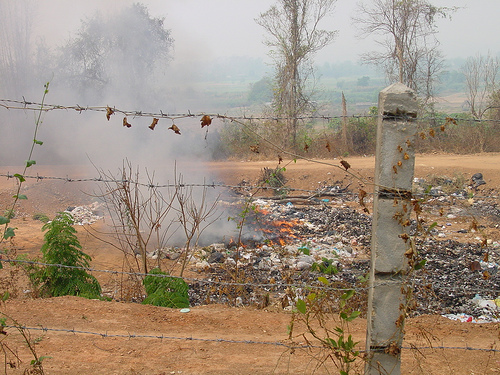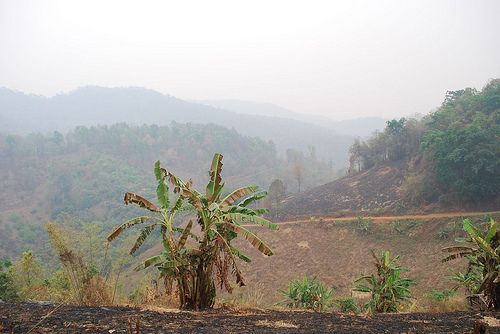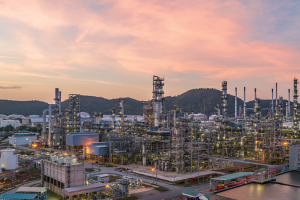On location in Thailand
A common comment on the weather in
Thailand is that there are two seasons - wet and dry. Lately though there has been a third season gaining prominence: the burning season. As farmers prepare their field for the growing season, many do so by setting their fields ablaze. There is also a substantial amount of forest land that is burnt for new farm fields. This is not only bad for the world renowned forests of northern Thailand, but also for breathing people everywhere.
With the specifics of northern Thailand geography, the smoke tends to hang in the air, choking farmers and residents of nearby cities, like
Chang Mai. Some governments have even issued warnings urging tourists to avoid these areas during prime burning time in the spring. When the particulates eventually move, it effects the larger cities to the south, such as
Bangkok, where most of Thailand's population lives. We are currently in the southeast along the coast and with the winds coming from the north some days smell like a campfire.
Reasons for field burning

Burning field in Pai, Thailand
There are many possible reasons for the burning: outdated farming techniques, lack of education regarding the effects on the land, air, and people, poor enforcement of protected areas, and so on. In Thailand there is much debate as to the primary driver of these practices, who is responsible for correcting them, and as a result who should shoulder the blame for their consequences. (See a broad based campaign
here.) There are even those that will deflect the responsibility away from Thailand claiming more of the burning is done in neighboring
Laos or
Myanmar. But a
recent study published in the Bangkok Post claims that farmers are burning forest land to farm corn for ethanol or other mono-crops that are being pushed by large agribusiness. These two themes (the evils of government subsidies and big-business) may be nothing more than convenient scapegoats as there is plenty of
evidence of farmers burning fields as a regular practice to remove the remains of the previous season's crop when traditional crops are planted.
Struggle between food and fuel
This is part of Thailand's version of the worldwide energy/food debate as food and energy compete for land and water resources that are being stretched farther and farther. The specifics may change, but the core factors remain the same. In the developed world the complaint is that the price of a steak goes up as the underlying feed cost increases. While in regions of the world where food costs gobble up a higher proportion of income, the object of debate is lower on the food chain, in the form of grain or oil used for basic cooking. This is a significant concern for governments that control the price of basic needs through subsidies or price controls.

Burnt Thai field awaits planting
The price of basic foods can be a main contributor to inflation. In some developing countries such as
Thailand and
China, the figure can reach 3% and 4% respectively, or as high as 9% in
India. Food prices are the source of
many demonstrations, as consumers feel they are being gouged and suppliers feel they are being shorted.
The strength of these pressures can be seen in recent government policy changes. In
March 2011, Energy Ministry of Thailand, the world's third largest producer of palm oil, diverted 5,000 tons of palm oil earmarked for biofuel production to be refined into cooking oil instead. 10,000 tons of privately held were likewise diverted for cooking oil production and an additional 30,000 tons were imported for domestic consumption.
In
October 2011 Thailand's mandate for biodiesel blends increased from 4% to 5% (percent of renewable stock in diesel). The continuation of this mandate is to be determined by stocks at the beginning of 2012.
Similar moves were made in other palm oil producing nations such as
Malaysia and
Indonesia, conflicting long term plans to increase biofuel production and short term moves to shore up local food supplies. As demand for what used to be basic commodities pushes up prices, inching them closer to cash crops, the once simple decision-making paradigms shift--and often at the expense of the environment or those least able to adapt to the change.
Any viable long-term energy solution will have to work within a web of cascading consequences; the most tangible may be how typical residents of the planet will feed themselves.
Images: sun in hazy Thai sky & burning field in Pai, meghantosh; burnt field awaiting planting, avlxyz
 Burning field in Pai, Thailand
There are many possible reasons for the burning: outdated farming techniques, lack of education regarding the effects on the land, air, and people, poor enforcement of protected areas, and so on. In Thailand there is much debate as to the primary driver of these practices, who is responsible for correcting them, and as a result who should shoulder the blame for their consequences. (See a broad based campaign here.) There are even those that will deflect the responsibility away from Thailand claiming more of the burning is done in neighboring Laos or Myanmar. But a recent study published in the Bangkok Post claims that farmers are burning forest land to farm corn for ethanol or other mono-crops that are being pushed by large agribusiness. These two themes (the evils of government subsidies and big-business) may be nothing more than convenient scapegoats as there is plenty of evidence of farmers burning fields as a regular practice to remove the remains of the previous season's crop when traditional crops are planted.
Burning field in Pai, Thailand
There are many possible reasons for the burning: outdated farming techniques, lack of education regarding the effects on the land, air, and people, poor enforcement of protected areas, and so on. In Thailand there is much debate as to the primary driver of these practices, who is responsible for correcting them, and as a result who should shoulder the blame for their consequences. (See a broad based campaign here.) There are even those that will deflect the responsibility away from Thailand claiming more of the burning is done in neighboring Laos or Myanmar. But a recent study published in the Bangkok Post claims that farmers are burning forest land to farm corn for ethanol or other mono-crops that are being pushed by large agribusiness. These two themes (the evils of government subsidies and big-business) may be nothing more than convenient scapegoats as there is plenty of evidence of farmers burning fields as a regular practice to remove the remains of the previous season's crop when traditional crops are planted.
 Burnt Thai field awaits planting
The price of basic foods can be a main contributor to inflation. In some developing countries such as Thailand and China, the figure can reach 3% and 4% respectively, or as high as 9% in India. Food prices are the source of many demonstrations, as consumers feel they are being gouged and suppliers feel they are being shorted.
The strength of these pressures can be seen in recent government policy changes. In March 2011, Energy Ministry of Thailand, the world's third largest producer of palm oil, diverted 5,000 tons of palm oil earmarked for biofuel production to be refined into cooking oil instead. 10,000 tons of privately held were likewise diverted for cooking oil production and an additional 30,000 tons were imported for domestic consumption.
In October 2011 Thailand's mandate for biodiesel blends increased from 4% to 5% (percent of renewable stock in diesel). The continuation of this mandate is to be determined by stocks at the beginning of 2012. Similar moves were made in other palm oil producing nations such as Malaysia and Indonesia, conflicting long term plans to increase biofuel production and short term moves to shore up local food supplies. As demand for what used to be basic commodities pushes up prices, inching them closer to cash crops, the once simple decision-making paradigms shift--and often at the expense of the environment or those least able to adapt to the change.
Any viable long-term energy solution will have to work within a web of cascading consequences; the most tangible may be how typical residents of the planet will feed themselves.
Burnt Thai field awaits planting
The price of basic foods can be a main contributor to inflation. In some developing countries such as Thailand and China, the figure can reach 3% and 4% respectively, or as high as 9% in India. Food prices are the source of many demonstrations, as consumers feel they are being gouged and suppliers feel they are being shorted.
The strength of these pressures can be seen in recent government policy changes. In March 2011, Energy Ministry of Thailand, the world's third largest producer of palm oil, diverted 5,000 tons of palm oil earmarked for biofuel production to be refined into cooking oil instead. 10,000 tons of privately held were likewise diverted for cooking oil production and an additional 30,000 tons were imported for domestic consumption.
In October 2011 Thailand's mandate for biodiesel blends increased from 4% to 5% (percent of renewable stock in diesel). The continuation of this mandate is to be determined by stocks at the beginning of 2012. Similar moves were made in other palm oil producing nations such as Malaysia and Indonesia, conflicting long term plans to increase biofuel production and short term moves to shore up local food supplies. As demand for what used to be basic commodities pushes up prices, inching them closer to cash crops, the once simple decision-making paradigms shift--and often at the expense of the environment or those least able to adapt to the change.
Any viable long-term energy solution will have to work within a web of cascading consequences; the most tangible may be how typical residents of the planet will feed themselves.





